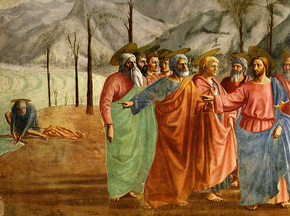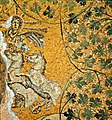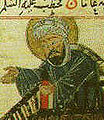gloriole


The halo , the halo or halo ( Latin nimbus , cloud ' , specifically, diadem';, Halo '; ancient Greek ἅλως halos , German , Tenne , rounding halo around the sun or moon, rays circle' ) is a light-emitting or light appearance to the head or the whole body of a person representation. Sub-forms of the nimbus, which encompass the entire body of the person depicted, are the circular "aureole" and the almond-shaped mandorla . In art, the nimbus is a symbol of the mighty, the enlightened, saints or gods. A luminous or light phenomenon, a sun crown or a halo (Latin: Corona radiata) around the head or body in depictions of special people is known in many cultures.
presentation
In art, the nimbus is represented in a variety of ways in holy, stately or divine figures. If it surrounds the whole figure in a circle, it is called "Aureole", in almond form " Mandorla ". Behind the head the halo is a "nimbus". There were also painters who dynamically related the nimbus to the movements of the head. It was painted bright and radiant, as if it were emitting a light (usually white, yellow, silver, or gold). Living personalities were sometimes depicted with a square nimbus.
Christ as Sol invictus with the seven-pointed sun crown of Helios in the sun chariot , detail of a ceiling mosaic in the Vatican necropolis
Constantine the Great (307–337) as Sol invictus. Minted approx. 309–310 in Lugdunum. Sol standing with his face to the right, right hand raised, the globe in his left with the seven-pointed halo of Helios .
symbolism
In ancient art, the nimbus was a symbol of power or the divine and was thus also given to depictions of various deities. Deified Roman emperors are also depicted with nimbuses on their coins. Sun gods such as B. Mithras and Helios often depicted with a ray of light or a sun crown around their heads; here the aureole is evidently a symbol for the shining sun that these gods symbolically embodied. In Zoroastrianism , the radiance symbolizes the sacred flame (or sacred light).
In Christian art , from the 2nd century onwards, the ancient glory was given first to the son of God Jesus Christ and the popes, then to the triune God and the angels , later to the mother of God Mary and finally to the saints. The shape of the cross nimbus of the divine trinity consisting of God the Son , God the Father and God the Holy Spirit is reserved and characterizes this.
Taking over the ancient and Christian symbols, the nimbus can also be found in the Holy Roman Empire of the Middle Ages, for example it adorns the simple (Roman-German king) and the double-headed eagle (Roman-German emperor) - but here, too, late Eastern Roman depictions of the nimbly eagle (see Locumtenenstaler and Lichttaler ). In the course of time, the nimbus became the accompanying symbol in depictions of gods or higher beings. Today the word nimbus is often used as a linguistic image without the visual image being connected with it.
Some forms of Christian mysticism have developed the special teaching of the Tabor light from the transfiguration of Jesus on Mount Tabor , as reported in the New Testament and observed by the apostles Peter , James and John .
Examples
Buddhism
The first head aureoles can be found in Buddhist art of the 1st or 2nd century; Above all, the art of Gandhara, which was under Hellenistic influence, should be mentioned here.
Buddha statue with nimbus, 1st / 2nd c. Century, Gandhara ( Afghanistan )
Buddha in asceticism, Taxila , 2nd / 3rd cent. Century
Buddha with nimbus, 5th / 6th centuries Century, Sarnath Museum
Five Buddhas of Wisdom, mandala in Taizokai, Japan
Christianity
In Christian inconography, the size of the halo decreased over time, until the nimbus was only depicted as a circular disk, a system of several concentric circles or a ring that is located behind or above the figure's head. In contrast to the nimbus of the saints, the halo of Jesus Christ is often depicted somewhat differently, especially on icons .
Justinian I , mosaic detail from the Church of San Vitale in Ravenna
Benedict of Nursia , fresco in the Monastery of Subiaco, Umbria, Italy, ca.550.
Pope Paschal I with a square halo, which identifies him as a person still alive at the time of the portrait. On a mosaic in the Basilica of Santa Prassede, 9th century.
Louis IX of France leader of two crusades , 16th century. Runa, Portugal.
Title page of the Index Librorum Prohibitorum , copper engraving from 1711
Elisabeth of Thuringia , painting by Edmund Blair Leighton , 1895.
Thomas Becket , English Lord Chancellor, stained glass by Samuel Caldwell Jr., Canterbury Cathedral, 1919.
6th century mosaic depicting Christ with a cross nimbus .
Baroque column of the Holy Trinity with a cross and aureole on an apple, Olomouc, Czech Republic, 1716–1754.
Radiant wreath Madonna in Altenberg Cathedral (around 1530)
Islam
In Shiite Islam, Ali ibn Abi Talib is depicted with a nimbus. From 1580 the nimbus depiction was often used in Indian Mughal painting for important personalities and rulers of the Mughal Empire . Also Yusef and Zueleikha (Joseph and Potiphar's wife) were presented with halo as evidence of their superior status.
Ilkhanid manuscript illustration depicting the inauguration of Ali ibn Abi Talib (front right with nimbus) on Ghadir Khumm.
Medieval depiction of Muhammad with a nimbus.
Mughal ruler Shah Jahan around 1630
literature
- Rainer Warland : Nimbus. In: Real Lexicon for Antiquity and Christianity . Volume 25, Hiersemann, Stuttgart 2013, ISBN 978-3-7772-1318-7 , Sp. 915-938
Web links
Remarks
- ^ Karl Ernst Georges : Comprehensive Latin-German concise dictionary . 8th, improved and increased edition. Hahnsche Buchhandlung, Hannover 1918 ( zeno.org [accessed on February 12, 2020] dictionary entry “nimbus”).
- ^ Wilhelm Pape , Max Sengebusch (arrangement): Concise dictionary of the Greek language . 3rd edition, 6th impression. Vieweg & Sohn, Braunschweig 1914 ( zeno.org [accessed on February 12, 2020]).
- ^ Bamber Gascoigne: The Mughals. Splendor and greatness of Mohammedan princes in India. Special edition. Prisma-Verlag, Gütersloh 1987, ISBN 3-570-09930-X , p. 146 ff.
- ^ Peter Lamborn Wilson , Karl Schlamminger: Weaver of Tales. Persian Picture Rugs / Persian tapestries. Linked myths. Callwey, Munich 1980, ISBN 3-7667-0532-6 , pp. 46-77 ( Die Liebesdichtung ), here: pp. 70 f.
























